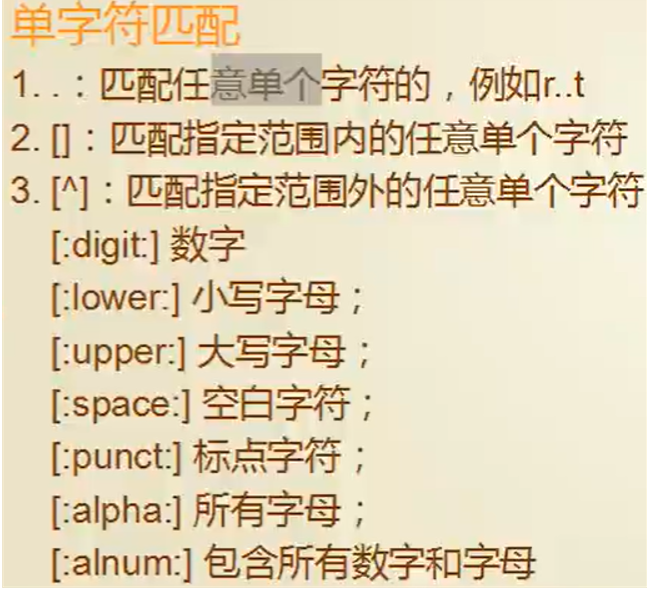正则表达式
正则表达式是由一些具有特殊含义的字符组成的字符串,多用于查找、替换符合规则的字符串。在表单验证、Url映射等处都会经常用到。
说简单点就是王者荣耀里的***。
作用
通过文件中的那人进行过了赛选,然后对文件的内容进行处理。经常用于基于正则写脚本来处理日志文件。
构成
一堆特殊符号和字母构成 ,一般称为元字符。
正则表达式的种类
-
基本正则表达式
-
扩展正则表达式
正则表达式的使用
通常都会结合三个命令使用,俗称三剑客。
-
grep
-
sed
-
awk
grep 命令
作用:对文件中内容进行逐行过滤
格式: grep [选项] 匹配内容 文件
选项:
-
-v 取反
-
-o 仅显示所匹配内容
-
-
-E 使用扩展表达式
-
-i 忽略大小写
例子:
1 [root@shell ttt]# cat grep_t.txt
2 a root if is and
3 -++ -i or dir
4 root bing ping pr
5 dors jlkf klj
6 are root you root am your
7
8 # 取反,也就是过滤掉有root的行输入没有root的行
9 [root@shell ttt]# grep -v root grep_t.txt
10 -++ -i or dir
11 dors jlkf klj
12
13 #直显示 root
14 [root@shell ttt]# grep -o root grep_t.txt
15 root
16 root
17 root
18 root
19
20 # 统计个数
21 [root@shell ttt]# grep -o root grep_t.txt | wc -l
22 4
23 [root@shell ttt]# grep --color root grep_t.txt
24 a root if is and
25 root bing ping pr
26 are root you root am your
通配符和正则的区别
-
通配符是对文件进行匹配的;正则表达式是对文件内容进行匹配的
-
正则表达式是要结合 grep、sed、awk使用
正则中的云字符
匹配元字符

实例:
1 [root@shell ttt]# cat grep_t.txt
2 a root 3 if is and
3 -++ -i or 4 dir
4 root bing 5 ping pr
5 dors jlkf 33 klj
6 are root 71 you root 7 am your
7
8 # 匹配前面一个字符后面是一个a的行
9 [root@shell ttt]# grep ".a" grep_t.txt
10 a root 3 if is and
11 are root 71 you root 7 am your
12 # 匹配前后有字符,中间有a的行号
13 [root@shell ttt]# grep ".a." grep_t.txt
14 a root 3 if is and
15 are root 71 you root 7 am your
16
17 # 匹配 0-9 范围内的任意字符
18 [root@shell ttt]# grep [1-9] grep_t.txt
19 a root 3 if is and
20 -++ -i or 4 dir
21 root bing 5 ping pr
22 dors jlkf 33 klj
23 are root 71 you root 7 am your
24 # 匹配所有数字范围内的任意字符
25 [root@shell ttt]# grep [[:digit:]] grep_t.txt
26 a root 3 if is and
27 -++ -i or 4 dir
28 root bing 5 ping pr
29 dors jlkf 33 klj
30 are root 71 you root 7 am your
31
32 # 匹配指定单词外的任意字符
33 [root@shell ttt]# grep "[^a]" grep_t.txt
34 a root 3 if is and
35 -++ -i or 4 dir
36 root bing 5 ping pr
37 dors jlkf 33 klj
38 are root 71 you root 7 am your
39 或
40 # 只匹配开头行
41 grep "^[^a]" grep_t.txt or grep -v "[^a]" grep_t.txt
1 -A n 显示匹配行后n行
2 -B n 显示匹配行前n行
3 -C n 显示匹配行前后的各n行
* 表示其前面的字符出现任意此次数的情况,(0,1,n)次数 ==> grep "a*b" 文件名 #匹配a后面b出现多次
.* 表示任意长度的任意字符 ==> grep "a.*b" 文件名 #过滤出包含字母a和b行,要求a在前,b在后
? 表示其前面最多出现一次的情况 ==> grep "a?b" 文件名 #过滤出b只能出现一次
\{m,n\} 表示其前面的字符出现最少m次,最多n次 ==> grep "a\{2,5\}b" 文件名 #过滤出b前面2-5个a
^ 锚定行首 ==> grep "^root" 文件名 #过滤出以root开头的行
$ 锚定行尾 ==> grep "root$" 文件名 #过滤出以root结尾的行
^$ 表示空白行 ==> grep "^$" 文件名 #过滤出空白行
\<或\b 字符必须作为单词首部出现 ==> grep "\<root" 文件名 #首单词为root的行
\>或\b 字符必须作为单词尾部出现 ==> grep "root\>" 文件名 #尾单词尾root的行
\( \) 将一个内容当做一个整体看待
\1 表示引用前面第一个分组 ==> grep "\([[:digit:]]\).*\1" 文件名 #过滤出两个相同数字的行
\2 表示引用前面第二个分组
扩展正则表达式
扩展表达式:
-
grep -E 匹配内容 文件
-
egrep 匹配内容 文件
支持字符匹配(. 、[] 、[^])、次数匹配(* 、?、{m,n})。
补充
在基本表达式中,? {} () 需要在前面使用 \ 进行转义
在扩展正则表达式中不需要的
1 # 过滤出bing 跟 Bing
2 [root@shell ttt]# grep -E "(b|B)ing" grep_t.txt
3 root bing 5 ping pr
4 Bing bing
5 # 直接过滤掉大小写 bing
6 [root@shell ttt]# grep -i bing grep_t.txt
7 root bing 5 ping pr
8 Bing bing



